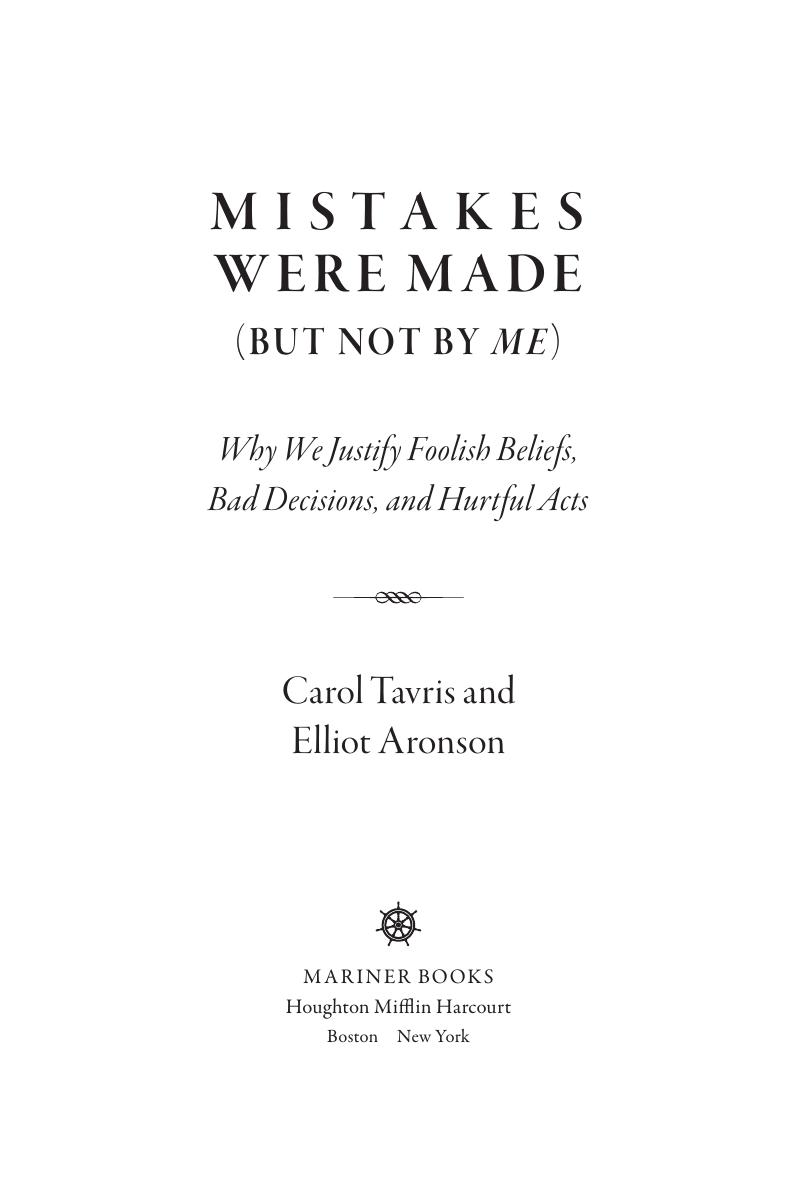Mistakes Were Made (but Not by Me) Third Edition by Carol Tavris;Elliot Aronson;

Author:Carol Tavris;Elliot Aronson;
Language: eng
Format: epub, pdf
ISBN: 9780547416038
Publisher: HarperCollins (Houghton Mifflin Harcourt)
Published: 2008-05-05T00:00:00+00:00
Contemptuous exchanges like this one are devastating because they destroy the one thing that self-justification is designed to protect: our feelings of self-worth, of being loved, of being a good and respected person. Contempt is the final revelation to the partner that âI donât value the âwhoâ that you are.â We believe that contempt is a predictor of divorce not because it causes the wish to separate but because it reflects the coupleâs feelings of psychological separation. Contempt emerges only after years of squabbles and quarrels that keep resulting, as for Frank and Debra, in yet another unsuccessful effort to get the other person to behave differently. It is an indication that the partner is throwing in the towel, thinking, âThereâs no point hoping that you will ever change; you are just like your mother after all.â Anger reflects the hope that a problem can be corrected. When it burns out, it leaves the ashes of resentment and contempt. And contempt is the handmaiden of hopelessness.
â¦
Which comes first, a coupleâs unhappiness with each other or their negative ways of thinking about each other? Am I unhappy with you because of your personality flaws, or does my belief that you have personality flaws (rather than forgivable quirks or external pressures) eventually make me unhappy with you? Obviously it works in both directions. But because most new partners do not start out in a mood of complaining and blaming, psychologists have been able to follow couples over time to see what sets some of them, but not others, on a downward spiral. They have learned that negative ways of thinking and blaming usually come first and are unrelated to the coupleâs frequency of anger or either partyâs feelings of depression.8 Happy and unhappy partners simply think differently about each otherâs behavior, even when they are responding to identical situations and actions.
That is why we think that self-justification is the prime suspect in the murder of a marriage. Each partner resolves the dissonance caused by conflicts and irritations by explaining the spouseâs behavior in a particular way. That explanation, in turn, sets them on a path down the pyramid. Those who travel the route of shame and blame will eventually begin rewriting the story of their marriage. As they do, they seek further evidence to justify their growing pessimistic or contemptuous views of each other. They shift from minimizing negative aspects of the marriage to overemphasizing them, seeking any bit of supporting evidence to fit their new story. As the new story takes shape, with husband and wife rehearsing it privately or with sympathetic friends, the partners become blind to each otherâs good qualities, the ones that initially caused them to fall in love.
The tipping point at which a couple starts rewriting their love story, Gottman finds, is when the âmagic ratioâ dips below five to one: Successful couples have a ratio of five times as many positive interactions (such as expressions of love, affection, and humor) to negative ones (such as expressions of annoyance and complaints).
Download
Mistakes Were Made (but Not by Me) Third Edition by Carol Tavris;Elliot Aronson;.pdf
This site does not store any files on its server. We only index and link to content provided by other sites. Please contact the content providers to delete copyright contents if any and email us, we'll remove relevant links or contents immediately.
The Art of Thinking Clearly by Rolf Dobelli(9951)
The 5 Love Languages: The Secret to Love That Lasts by Gary Chapman(9314)
Mindhunter: Inside the FBI's Elite Serial Crime Unit by John E. Douglas & Mark Olshaker(8750)
Becoming Supernatural by Dr. Joe Dispenza(7869)
The Road Less Traveled by M. Scott Peck(7301)
Nudge - Improving Decisions about Health, Wealth, and Happiness by Thaler Sunstein(7273)
Mastermind: How to Think Like Sherlock Holmes by Maria Konnikova(6956)
Enlightenment Now: The Case for Reason, Science, Humanism, and Progress by Steven Pinker(6891)
Win Bigly by Scott Adams(6846)
The Way of Zen by Alan W. Watts(6305)
Factfulness: Ten Reasons We're Wrong About the World – and Why Things Are Better Than You Think by Hans Rosling(4506)
The State of Affairs by Esther Perel(4499)
Gerald's Game by Stephen King(4391)
Man's Search for Meaning by Viktor Frankl(4310)
The Confidence Code by Katty Kay(4055)
Thinking in Bets by Annie Duke(4020)
The Worm at the Core by Sheldon Solomon(3332)
Hidden Persuasion: 33 psychological influence techniques in advertising by Marc Andrews & Matthijs van Leeuwen & Rick van Baaren(3313)
Enlightenment Now by Steven Pinker(3282)
